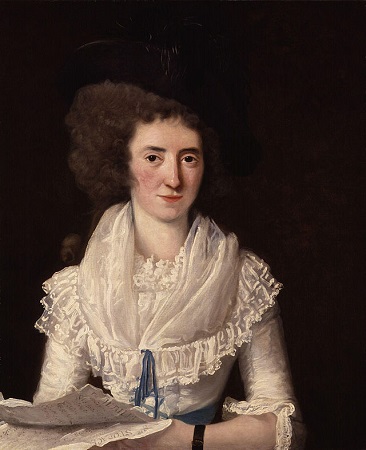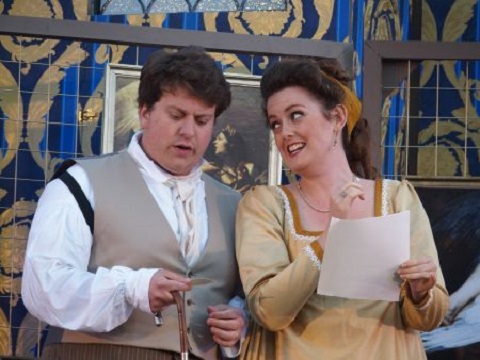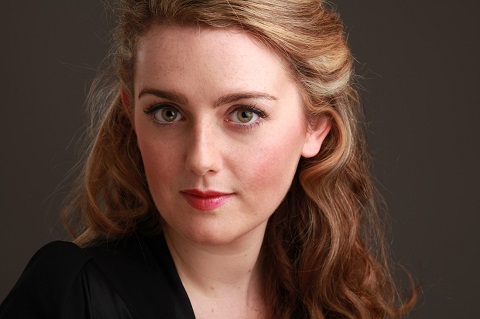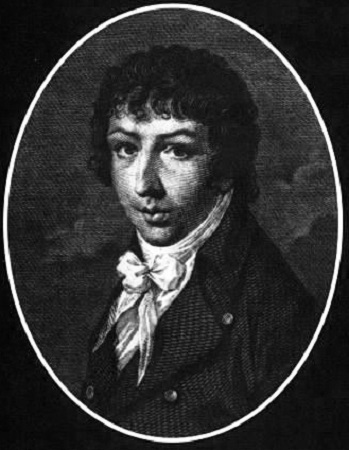Anglo-Italian soprano Ann Selina (Nancy) Storace (1765-1817) was renowned
for her vocal prowess and remarkable stage presence, enjoying a glittering
career across Europe. Recruited for Emperor Joseph II’s new Italian opera
company, she dazzled audiences in 18th-century Vienna and enthralled the
leading composers of the day; not least one Wolfgang Amadeus Mozart who
created the role of Susanna in Le nozze di Figaro
specifically for her.
Nancy’s father, Stefano, originally from Naples, was a professional double
bass player in London and Dublin. He recognized the talent exhibited by his
eight-year-old daughter, who could sing sweetly and sight-read
effortlessly, and nurtured her precocity - perhaps, some have suggested, at
the price of a long-lived career. In August 1773, she appeared in Hampshire
with the violinist Ximenez, and their concert was so successful that a
repeat was demanded. (So, Stefano left his young daughter alone in
Southampton, while he travelled to Worcester to perform in the Three Choirs
Festival!)
[1]
Stefano arranged for Nancy to study in London with the Italian castrato and
composer Venanzio Rauzzini (1746-1810) and, at the age of eleven, she took
a minor role in his opera, L’ali d’amo. Two years later, she and
her parents travelled to Italy to join her brother Stephen, a composer, and
immediately she impressed in Naples and Florence. She was not yet
sufficiently wise to the profession’s games and pitfalls, however, and
found herself sacked from the Florentine Pergola Theatre, after she
offended the castrato Luigi Marchesi whose vocal tricks she dared to
effortlessly imitate.
The Storaces travelled to Lucca, Leghorn (where she met life-long friend,
the Irish tenor Michael Kelly), Milan, Parma and Venice. Success, and
wealth, seemed hers for the taking. An Imperial talent scout, Count
Durazzo, snapped her up (along with Kelly) and Nancy found herself
installed as prima donna of opera buffa at Emperor Joseph II’s
Burgtheatre. By 1782, at the age of just seventeen, she was undoubtedly a
European star.
Nancy’s ambitious mother encouraged her to marry the wealthy violinist and
music scholar, John Abraham Fisher, who was more than twice her age.
Fisher’s threatening, violent behaviour led the Emperor to order his exile,
and thereafter there was much speculation about Nancy’s private life - was
she the mistress of Mozart, or even the Emperor? In February 1787,
following a quarrel between Kelly and a Bohemian officer, and Stephen
Storace’s drunken antics at a ball, the Storace clan returned to London.
Nancy had caught the eye of the young English aristocratic Lord Barnard,
and after they had travelled homeward together he attended the performance which marked her return to London: a royal gala performance of Paisiello’s Gli schiavi per amore (The slave of love) at the King’s Theatre
Haymarket on 24th April 1787 London, that was attended by the
Prince of Wales. Yet, just three months later, Barnard had deserted Nancy
and married.
She maintained a discrete liaison with the Jewish tenor John Braham, nine
years her junior, with whom she toured Europe in 1797. Although they could
not marry (as Fisher was still living, until 1806), they set up house and a
son, William Spencer Harris Braham, was born on 3rd May 1802.
 Anna Selina Storace (c.1790) by Benjamin Van der Gucht (1753-1794) from the Collection of the National Portrait Gallery.
Anna Selina Storace (c.1790) by Benjamin Van der Gucht (1753-1794) from the Collection of the National Portrait Gallery.
During these years, Nancy’s voice was beginning to fade and, while her
acting abilities continued to be praised, in 1801 the Times noted
that her voice was ‘occasionally affected by a little hoarseness’; the same
year the Chronicle suggested that ‘she would do more … if
she attempted to do less’.
[2]
Nancy retired in 1808: her farewell to the stage was her brother’s No Sing, No Supper, alongside her old friend Kelly. Her
relationship with Braham deteriorated - he eloped at end of 1815 with
Sophie Wright, who had been a close friend of the couple - and she died in
1817 in Dulwich.
So, was Nancy was one of the 18th century’s operatic darlings?
Or, as one scholar has suggested, was she ‘exploited not only by theater
managers and impresarios, but by family and friends as well, who used her
for their own purposes.’
[3]
Bampton Classical Opera marks the bicentenary of Nancy’s death with a
fascinating concert of music associated with her, including arias sung by
sopranos Jacquelyn Stucker, currently a Jette Parker Young Artist at the
Royal Opera (whose roles this season include Azema (
Semiramide
), Countess Ceprano (Rigoletto) and Frasquita (
Carmen
)) and Rhiannon Llewellyn, who sang the role of the Countess in the
company’s production of Salieri’s
The School of Jealousy
last year. The performance will be conducted by Andrew Griffiths, a
graduate of The Royal Opera’s JPYA Programme. The concert brings together a
number of significant works with which Nancy was linked.
 Alessandro Fisher (Count) and Rhiannon Llewellyn (Countess) in Salieri’s The School of Jealousy, Bampton Classical Opera, 2017.
Alessandro Fisher (Count) and Rhiannon Llewellyn (Countess) in Salieri’s The School of Jealousy, Bampton Classical Opera, 2017.
I spoke with both Jacquelyn and Rhiannon as they prepared to inhabit the
legendary soprano’s shoes. I was interested in whether young singers
training today are taught about, or consider, past singers and historic
contexts? For example, if one is learning the role of Susanna, does one
reflect on the first performance and the role’s initial interpreter?
Jacquelyn explained that, while she could not speak for all young singers,
“looking up the soprano who premiered a role that interests me is how I
discover new repertoire, particularly for Baroque and Classical works. I do
think that the way we sing now is different from the way singers would sing
in the past - for example, the most powerful part of a soprano’s voice in
Handel’s heyday was right in the middle of the staff, which is why the A
sections of his da capo arias always feature a cadence right in
the middle of the soprano vocal range. Ask most sopranos singing now about
their middle voice (myself included!), and I’m willing to bet that you’ll
get a variety of responses: an eye-roll, a shrug, perhaps some
self-effacing laughter.
“And, here’s why: in terms of modern technique, it can really be a
temperamental part of the voice, whereas the voice at the top of the staff
is much more secure for sopranos [which also, she explains, relates to how
instruments and orchestras have changed]. To address this, sopranos now
often ornament these final cadences into the highest parts of their range -
it’s in the spirit of what Handel intended, but it accommodates modern
technique. So, I think taking a few minutes to be aware of the singer who
created a role is always wise as an awareness of what has been done before
can serve to inform our own choices. However, times and expectations and
techniques have changed apropos how we study and listen to and execute
works in the Western canon, and the only way to possibly add something to
the larger artistic discourse is to use our unique voices to declaim the
text as truthfully and as diligently as we can.”
 Jacquelyn Stucker. Photo courtesy of IMG Artists.
Jacquelyn Stucker. Photo courtesy of IMG Artists.
Obviously ‘career paths’ are very different today … but, I wondered whether
the challenges that singers such as Storace faced bore any resemblance to
the hurdles that young professionals today have to climb? Interestingly,
both Jacquelyn and Rhiannon were keen to emphasise some of the factors and
circumstances that had stayed the same or changed only a little. For
Jacquelyn, “Performing new music is a huge part of my professional life,
and it sounds like it was an important part of Nancy’s as well! This
programme of music written especially for Nancy Storace has reaffirmed for
me how important it is for singers of any generation to collaborate with
living composers and perform new music. In my experience, composers enjoy
writing music that singers want to sing, that feels good to sing - seeing
how Haydn, Stephen Storace, Salieri, and Mozart all achieved this within
their own musical language only reaffirms for me how productive and
creative the composer-singer relationship can be.”
Interestingly, Jacquelyn is currently preparing for a solo recital
presented through the Jette Parker Young Artist Programme which comprises
three large works: one UK premiere, one European premiere, and one world
premiere - and, two of the three composers featured on the concert are
travelling to London from the US to attend the recital. The recital is
entitled Fragments of Life: Songs of Loss, of Memory, of What Happens Next,
and Jacquelyn’s excitement at being able to bring works by Federico Favali,
John Harbison, and Mark Kilstofte to the London music scene is clear. The
performance is at 1pm at St. Clement Danes on The Strand on Monday 26 th March, and admission is free - “And, really, when else would
you get to hear a world premiere on your lunch break?”
Is the need for present-day singers to ‘promote’ themselves via social
media etc. actually quite similar to Stefano’s promotion of his daughter,
albeit in different contexts? And, Nancy was propelled into the limelight
at such an early age: not so different from some modern child-stars,
perhaps?
Jacquelyn remarked, “I cannot even imagine the pressure she must have been
under! I also read that she had a unique and vibrant personality, so a part
of me thinks she was, even at such a tender age, up for the challenge of
being in the public eye for a significant part of her adolescence.
“My perspective on this subject is heavily influenced by my experience as a
singer trained in the United States, but I do think there is a similar
pressure on singers now to promote themselves: get the ‘right’ headshots,
make a ‘proper’ website, matriculate into the ‘posh’ YAPs - to curate a
public image, a brand, a pedigree. In my opinion, there is less pressure to
do this here in the UK, but there is significantly more pressure to really
say something artistically in a powerful way every time you open your mouth
to sing. There is also more demanded of singers in terms of their dramatic
ability. I fully admit that my view of this profession is more narrow than
I’d like it to be, but these are the honest impressions I have based on
working in both of these countries. Truth be told, I’m grateful for both
approaches to modern professionalism. I think they are essential to
becoming a well-rounded modern performer-entrepreneur, which is the global
expectation at large, as I perceive it, for young singers.”
 Rhiannon Llewellyn.
Rhiannon Llewellyn.
Then there’s the question of needing to travel to develop and nurture a
budding career. While it must have been much more taxing in a practical,
and financial, sense in the eighteenth century, it never ceases to amaze me
how singers today seem to have to whizz, exhaustingly, around the globe at
the drop of an audition-invitation.
Rhiannon agreed that there are some similarities but noted that one
essential difference is that to travel to from London to Vienna in the
late-eighteenth century was no casual enterprise: one needed not
inconsiderable money and time. The Storaces’ journey to Europe took months
of planning and fundraising. And, once you had arrived, you stayed put.
Nowadays, singers are constantly receiving last minute calls to travel to
Oslo or Zurich or further afield to undertake auditions, the outcomes of
which are uncertain. “It sometimes feels as if one is constantly gambling.”
Storace and Cornetti are really just ‘names from history’ today; audiences
have little knowledge of or familiarity with their music. As a singer, is
there a difference in the way that one prepares such repertoire? Jacquelyn
observed, “My approach to repertoire is always the same no matter if the
piece is well-known or not: I always start with the most complicated
element, which is (based on the repertoire I tend to sing) either the words
or the rhythms. I always like to cmemorize the poems and speak them to
myself constantly. (It drives my husband totally crazy.) Then, I work out
the notes as much as I can away from the piano. Sight-singing the vocal
part helps it stick in my brain better, for some reason - I think it helps
me work out how the piece is organized, and understanding form is how I
memorize pieces. I like having one approach for everything I sing - it
makes assimilating music much faster; I have a technique that works, and I
apply it every time. It took me a few years to figure out my method, but
this has worked for me over the past three years.”
One among many of the less familiar and more intriguing works on Bampton’s
Storace programme is the cantata Per la ricuperata salute di Ofelia, which, I think, is receiving
its first full performance since it was presented with harpsichord
accompaniment
in 2016
, following the rediscovery of a printed score from 1785 in the archives of
the Czech national music.
The title of the cantata (‘For the recovered health of Ophelia’), for which
Lorenzo Da Ponte wrote the libretto, derives from the work’s origins. It
was designed to celebrate Storace’s recovery after a ‘vocal crisis’ at the
age of nineteen forced the singer to retreat from the stage for four
months. Chancellor describes how, in June 1785, Nancy suddenly lost her
voice at the beginning of the premiere performance of her brother's opera Gli sposi malcontenti: ‘Though it was then tactfully rumored that
this resulted from the emotional stress of an unhappy marriage, it is much
more credible that the strain of being eight months pregnant—her child died
soon after birth the following month—and the added stress of an appearance
before the emperor and the Duke of York, then on a state visit, while she
was suffering from a throat infection, were the real causes of the
disaster.’
[4]
Her return to the stage seems to have brought about a collaboration between
composers, Salieri and Mozart (and the little-known Cornetti), so often
considered bitter rivals.
 Stephen Storace.
Stephen Storace.
Jacquelyn considers the music of Per la ricuperata salute di Ofelia as “anything but dramatic or
florid, in my opinion! It is balanced, it embraces simplicity, and it has a
bit of a wide compass in the vocal line, much in the way ‘Deh, vieni’
[which she is also performing in the Bampton programme] does. In practising
this work, I’ve decided that its charm lies in how exposed it is for the
singer, and how well the singer can simply sing a beautiful legato line.
Interesting, Rhiannon makes similar observations about another contemporary
‘hit’, written especially for Nancy by Martin y Soler: ‘Dolce mu parve un
di’ from Una cosa rara, finding the aria lyrical and sensuous. Jacquelyn
also remarks that ‘Deh, vieni’ and the role of Susanna in general “does not
sit particularly high in the voice - which is what Nancy was known for,
from what I’ve read”. Rhiannon - who has recently been singing the role of
the Countess in Figaro, with The Merry Opera Company,
similarly finds ‘Porgi amor’ beautiful but quite low-lying. She added:
“Look at the roles she sang! Despina is a pretty, party-girl, who doesn’t
take things too seriously. I think that this was Nancy … it was, and is,
okay to be a little irreverent at times!”
Jacquelyn agreed, “I am of the opinion that Susanna [Figaro] was
modelled more after Nancy’s personality than her instrument, and I think
that’s kind of fantastic. Whether or not this is accurate, I love thinking
that a composer would write a piece for a singer as a human being with a
voice and not just a voice with a personality attached.” Similarly,
Rhiannon suggested that the music written for her confirms that Nancy
Storace must have first and foremost been a terrific actress - this might
explain some of the vocal writing, which is almost “nonsensical at times!”
Mozart’s ‘Ch’io mi scordi di te’ was written for Nancy’s farewell concert
in Vienna which took place on 23rd February 1787 (with Mozart
playing the piano obbligato part). I asked Jacquelyn if she sensed her
predecessor’s vocal strengths and qualities in this concert aria? Is this
aria, and the role of Susanna, a ‘tribute to her talent’?
“Absolutely. Nancy was known earlier in her career for her amazing high
notes, but she must have had, in the later stages of her singing life,
truly remarkable command over her lower passaggio (which is, for us lighter
sopranos, a tricky part of the voice). This concert aria also places the
text in the middle of the voice, which means articulating the words is much
easier than in other concert arias Mozart wrote. Because of this, it’s
clear to me that Nancy must have been a dynamic performer with an
unshakeable commitment to text. She definitely left some big shoes to fill,
but I love knowing that Mozart wrote this amazing music for a spitfire of a
woman who also happened to be an amazing musician.”
Claire Seymour
Bampton Classical Opera, Songs for Nancy: St John’s Smith
Square, 7th March 2018, 7.30pm
Jacquelyn Stucker and Rhiannon Llewellyn (sopranos), Andrew Griffiths
(conductor and piano), CHROMA
Concert programme: Sarti - Fra i due litiganti il terzo gode,
Overture; Mozart - Le nozze di Figaro, ‘Giunse al fin il momento …
Deh vieni’; Stephen Storace - No song, no supper, Overture &
‘With lowly suit’; Salieri - La scuola de’ gelosi, Overture &
‘Or ei con Ernestina … Ah sia già de’ miei sospiri’; Haydn - Cantata, Miseri noi, misera patri & Symphony No.83 (‘The Hen’); Martin
y Soler - Una cosa rara, ‘Dolce mi parve un di’; Mozart, Salieri,
Cornetti - Cantata, Per la ricuperata di Ofelia; Mozart -‘Ch’io mi
scordi di te’ K505.
[1]
See V.E. Chancellor, ‘Nancy Storace: Mozart’s Susanna’, The Opera Quarterly, Volume 7, Issue 2, 1 July 1990:
104-124.
[2]
Isabelle Putnam Emerson, Five Centuries of Women Singers
(Praeger, 2005)
[3]
Chancellor, op.cit., p.105.
[4]
Chancellor, op.cit., p.107.





